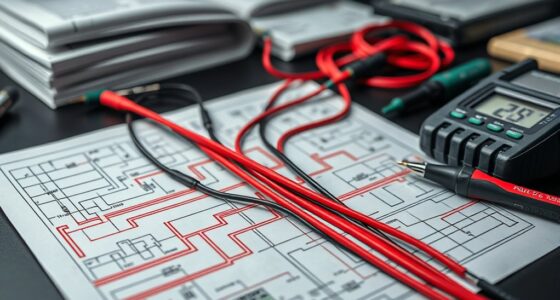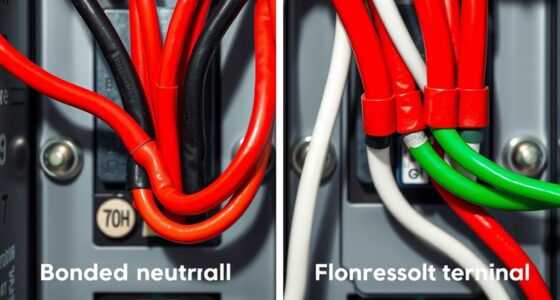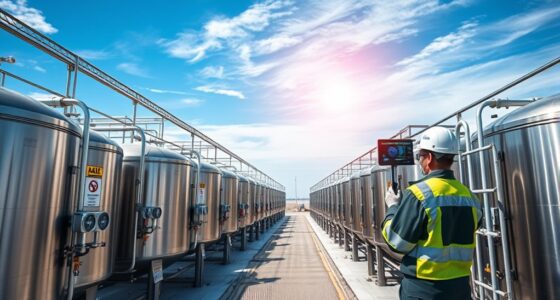To become confident with CO safety sensors on your generator, start by understanding their importance: they monitor air for dangerous carbon monoxide levels and trigger alarms or shutdowns when needed. Proper placement, regular calibration, and maintenance are key to ensuring each sensor functions reliably. By keeping these factors in check, you’ll protect yourself and loved ones from silent CO risks. If you continue exploring, you’ll discover essential tips to keep these systems working effectively.
Key Takeaways
- Proper sensor placement near exhaust at breathing level ensures accurate detection of CO buildup.
- Regular calibration maintains sensor accuracy and prevents false alarms or missed warnings.
- Continuous monitoring with advanced sensors provides early alerts before CO reaches hazardous levels.
- Routine maintenance, cleaning, and sensor replacement keep detection systems reliable and effective.
- Effective alarms and safety protocols enable quick response and evacuation, safeguarding occupants.
Understanding the Role of CO Safety Sensors in Generators
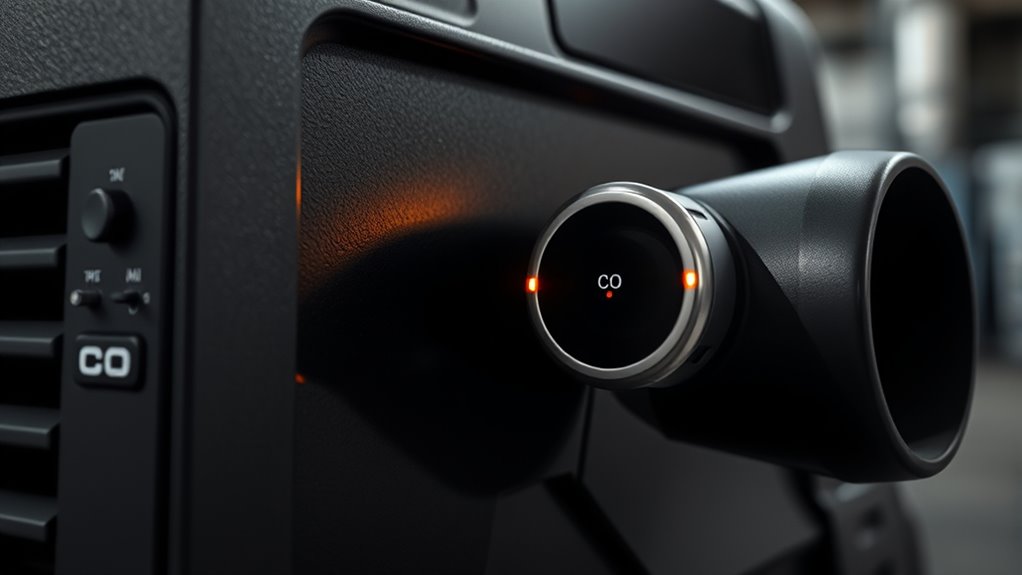
Carbon monoxide (CO) safety sensors are essential components in generators because they detect dangerous levels of CO gas produced during operation. Proper CO sensor calibration guarantees the sensor accurately reads gas levels, preventing false alarms or missed detections. Regular calibration helps maintain reliable performance, so you can trust your safety system. When it comes to sensor placement guidelines, position the sensor where it can effectively monitor the exhaust area without being obstructed or exposed to direct water or debris. Ideally, place it at breathing level, close to the generator’s exhaust outlet, but away from vents or airflow disruptions. Correct placement and calibration work together to provide early warnings, keeping you and your environment safe from CO poisoning risks during generator use. Calibration accuracy is crucial to ensure the sensor’s effectiveness over time and to maintain safety standards.
How CO Safety Sensors Detect and Respond to Dangerous Gases

CO safety sensors detect dangerous gas levels by constantly monitoring the air around the generator’s exhaust and surrounding environment. They use advanced gas detection technology to identify elevated levels of carbon monoxide quickly. When these sensors detect a rise in CO concentration, they trigger an immediate response, such as activating alarms or shutting down the generator to prevent harm. Regular sensor calibration is essential to guarantee accurate readings; this process fine-tunes the sensors, maintaining their reliability over time. Without proper calibration, sensors may produce false alarms or fail to detect dangerous gases. Additionally, proper maintenance ensures sensor longevity and optimal performance. By continuously monitoring and responding to gas levels, these sensors help keep you safe, minimizing the risk of CO poisoning during generator operation.
The Technology Behind CO Safety Sensors: Sensors and Alarms

Understanding the technology behind CO safety sensors involves recognizing how their sensors and alarms work together to protect you. These sensors detect carbon monoxide levels by measuring changes in electrical currents caused by the gas. When CO concentrations rise to dangerous levels, the sensor triggers the alarm to alert you immediately. Proper sensor calibration is essential; it guarantees the sensor accurately detects carbon monoxide and avoids false alarms or missed dangers. During regular maintenance, calibrating the sensor keeps it functioning effectively. The alarms are designed to sound loudly enough to wake you, giving you time to evacuate or shut down the generator. This combination of precise sensors and reliable alarms creates a crucial safety system that keeps you protected from carbon monoxide poisoning.
Benefits of Using CO Safety Sensors for Home and Outdoor Use
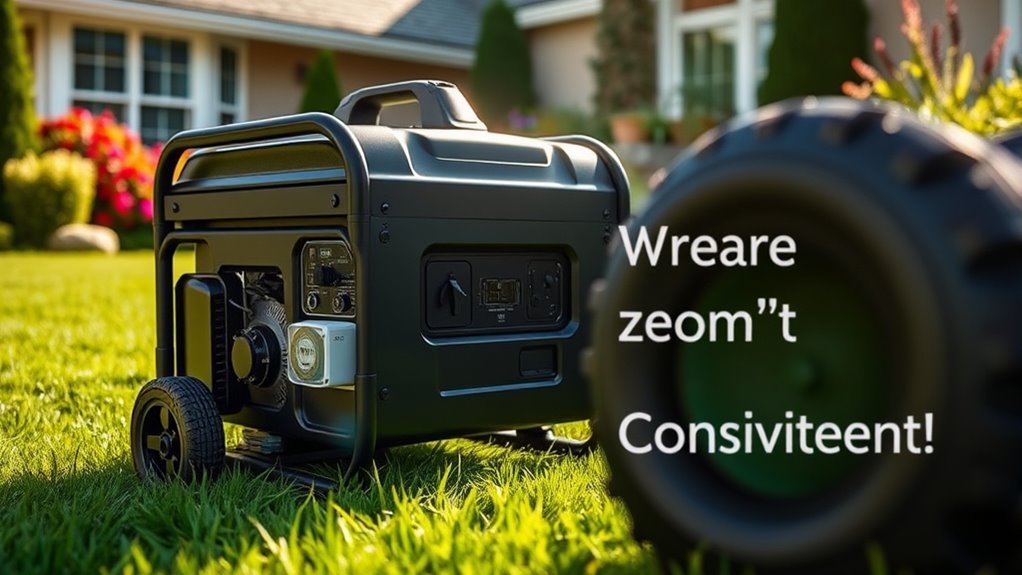
Using CO safety sensors in your home or outdoor spaces substantially enhances your safety by providing early detection of dangerous gas levels. These sensors alert you before carbon monoxide reaches hazardous levels, allowing you to take quick action. For generator safety, installing CO safety sensors ensures you’re warned if the gas accumulates near operating equipment, preventing poisoning risks. Outdoors, they help monitor areas where generators run, especially in enclosed or semi-enclosed spaces. This proactive approach minimizes the danger of silent CO buildup, which is hard to detect without sensors. Additionally, understanding the importance of color accuracy in safety devices can ensure that indicator lights and alerts are clearly visible and distinguishable in various lighting conditions. Overall, CO safety sensors offer peace of mind by continuously monitoring your environment, helping you protect loved ones and property from the deadly effects of carbon monoxide. They’re an essential addition for safe generator operation at home and outside.
Tips for Maintaining and Ensuring Proper Function of CO Safety Sensors
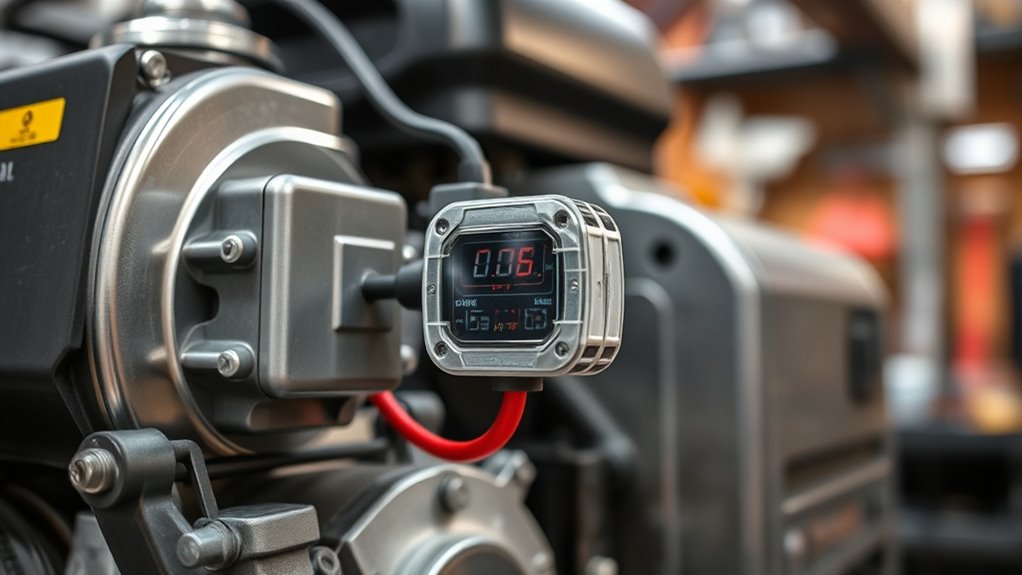
Regular maintenance is key to ensuring your CO safety sensors function correctly when you rely on them for generator safety. Regularly check and perform sensor calibration to keep readings accurate. If your sensor shows signs of malfunction or becomes outdated, prompt sensor replacement is essential. Keep your sensors clean and free of dust, dirt, and debris that can interfere with detection. Test your sensors periodically to confirm they activate correctly in response to carbon monoxide. Don’t ignore alarm alerts or irregular readings—they could be life-saving signals. Properly maintaining and understanding the glycolic acid benefits in your skincare routine can also contribute to overall well-being.
Regularly test, calibrate, and replace CO sensors to ensure reliable detection and safety.
- Feel confident knowing your home or outdoor space is protected.
- Avoid dangerous false alarms or undetected CO leaks.
- Ensure your sensors are always ready when you need them most.
- Trust your safety with proper maintenance and timely replacements.
Frequently Asked Questions
How Often Should CO Safety Sensors Be Replaced?
You should replace CO safety sensors every 3 to 5 years, but always check the sensor calibration regularly. The sensor lifespan varies based on usage and environmental factors, so stay vigilant for signs of malfunction or false alarms. Regular maintenance and testing ensure your sensors work correctly, keeping you safe. If the sensor shows signs of wear or calibration issues, substitute it sooner to maintain reliable carbon monoxide detection.
Are CO Sensors Effective Against All Types of Gas Leaks?
CO sensors are highly effective for detecting carbon monoxide, but they don’t cover all gas leaks. Gas detection with these sensors targets specific gases like CO, so for other leaks, like natural gas or propane, you’d need specialized sensors. Regular sensor calibration is vital to guarantee accuracy, and you should consider adding multiple sensors for all-inclusive safety. Always follow manufacturer guidelines to maximize detection reliability and safety.
Can CO Safety Sensors Work During Power Outages?
When the power’s out, your CO safety sensors can still do their job if they have backup batteries. Gas detection depends on properly calibrated sensors, so make sure you keep up with sensor calibration regularly. These sensors are designed to detect dangerous CO levels independently of the main power supply, giving you peace of mind during outages. Don’t leave safety to chance—trust your sensors, and they’ll watch over you no matter what.
Do Different Generator Models Require Different CO Sensor Types?
You should know that different generator models may require specific CO sensor types to guarantee compatibility. To maintain proper function, you need to check your generator’s compatibility and follow the manufacturer’s guidance. Sensor calibration is essential for accurate readings; some models may need calibration after installation or over time. Always consult your generator’s manual and consider professional installation to ensure your CO safety sensor works effectively and safely.
What Are COmmon False Alarms Caused by CO Sensors?
Imagine a silent guardian, but sometimes it sounds the alarm prematurely. False alarms in carbon monoxide detection often happen because of dust, humidity, or vehicle exhaust fumes near the sensor. These false alarm triggers can be frustrating, but regular maintenance and proper placement help. You can prevent unnecessary shutdowns by ensuring your sensor isn’t exposed to such environmental factors, keeping your safety system reliable and your mind at ease.
Conclusion
So, you’ve got your CO safety sensors on your generator—perfect, right? Ironically, the very device meant to save you from danger might go unnoticed until it’s too late. Don’t let silence or neglect be your downfall. Regularly check and maintain your sensors, because in the end, a little effort now keeps the danger at bay. After all, it’s better to be safe than sorry—especially when your life depends on it.


